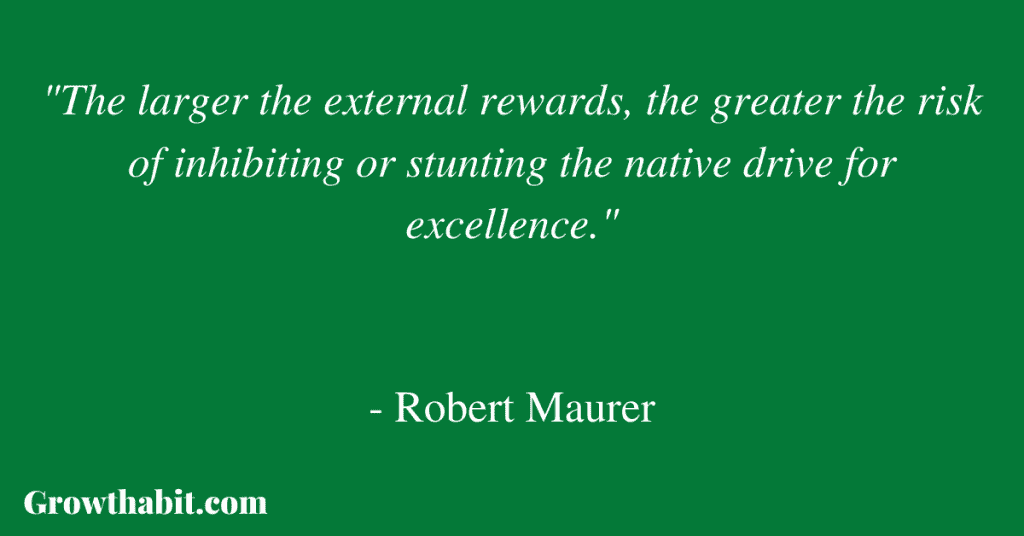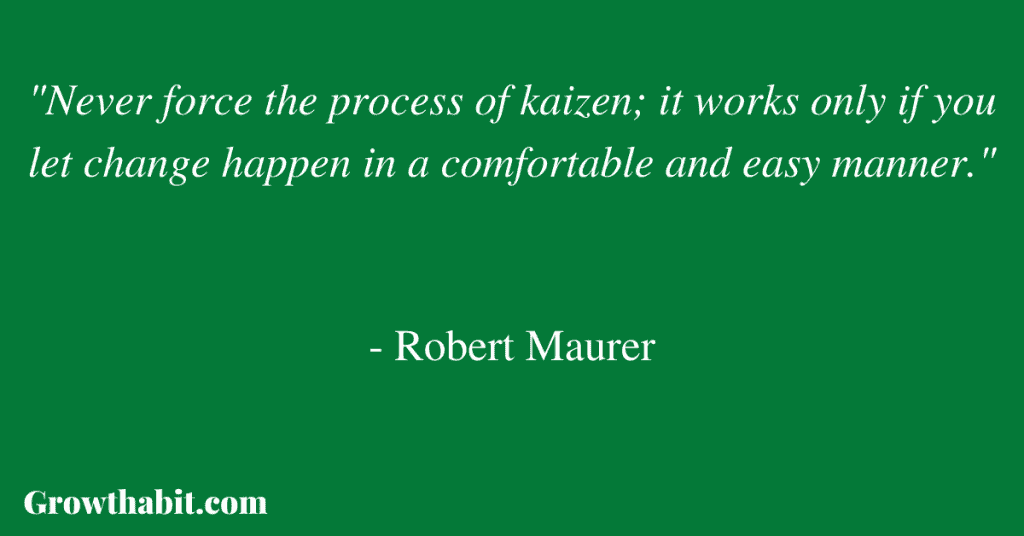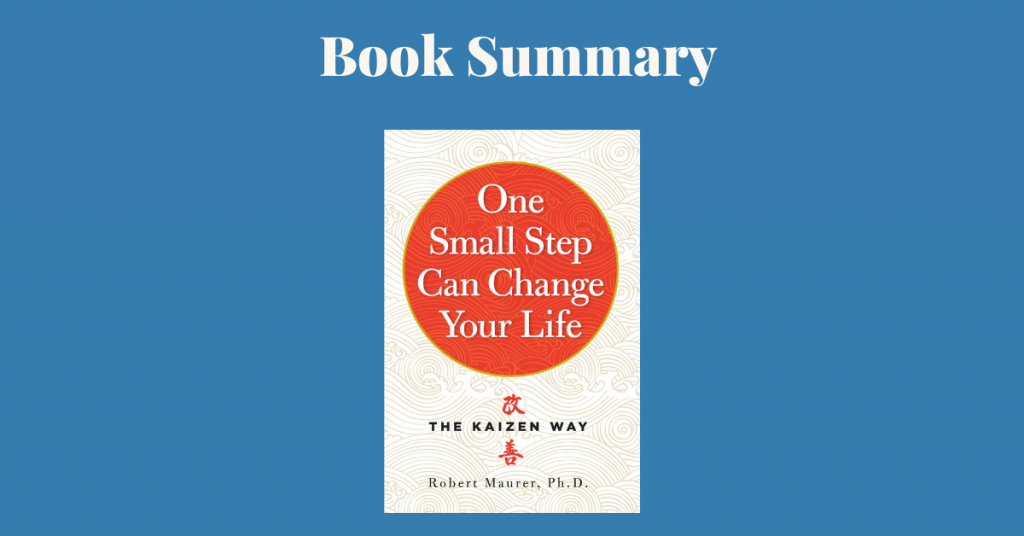The greatest change is made through the smallest steps and that’s the essence of the Kaizen way. Kaizen— Japanese for continuous improvement— is a principle that states you can overcome the fear of change and procrastination through small, incremental steps that eventually transform your life.
Book Title: One Small Step Can Change Your Life: The Kaizen Way
Author: Robert Maurer Ph.D.
Date of Reading: June 2017
Rating: 6/10
What Is Being Said In Detail:
The book can be best summarized as a”how-to” for the quote of “A journey of ten thousand miles begins with a single step.”
One Small Step Can Change Your Life teaches us how versatile the application of Kaizen is in our daily lives. Everything from losing weight to becoming an artist to learning a new skill to building a business to saving money— Kaizen can help with all of those challenges. With the mindset of thinking small thoughts that leads to taking small actions that turn into solving small problems, no challenge is insurmountable.
Chapter 1 teaches us why Kaizen work and the science behind it (it involves bypassing the amygdala’s response).
Chapter 2 teaches us to ask small answers because that leads to small answers (and steps in the right direction). There are no limits to small answers— you create your own Kaizen by defining how small is enough for you to take action.
Chapter 3 teaches us to think small thoughts. That way, the daunting task of reading 50 books a year never comes to our mind to scare us. Instead, a mere “read 10 pages a day” seems small (and easy) enough to do.
Chapter 4 teaches us to take small actions and focus just on them and ignore the bigger goal.
Chapter 5 teaches us to solve small problems. This is about “killing the monster while it’s small.” You can deal with problems before they become too big because once they do, they spiral out of control and require massive action-taking and motivation. If you clean for 5 minutes every day, the dust won’t have time to collect. If you don’t clean for a year, you will need to call Kim&Aggie to help you do it.
Chapter 6 teaches us about having small rewards. Once you start implementing Kaizen in your life, you can use small rewards to motivate that behavior even further. The rewards can be both intrinsic and extrinsic.
Chapter 7 teaches us to enjoy life and be present because that’s how we can appreciate, notice, and identify small moments. And those small moments can make a massive difference in our lives and the lives of people around us.
Chapter 8 teaches us to live Kaizen for the rest of our lives and try to implement it wherever we can to improve.
Most Important Keywords, Sentences, Quotes:
That’s the problem with innovation. Too often, you meet with success in the short term, only to find yourself falling back into your old ways when your initial burst of enthusiasm fades away. Radical change is like charging up a steep hill-you may run out of wind before you reach the crest, or the thought of all the work ahead makes you give up no sooner than you’ve begun.
“A journey of a thousand miles must begin with the first step.”
“When you improve a little each day, eventually big things occur. When you improve conditioning a little each day, eventually you have a big improvement in conditioning. Not tomorrow, not the next day, but eventually a big gain is made. Don’t look for the big, quick improvement. Seek the small improvement one day at a time. That’s the only way it happens and when it happens, it lasts. “
-John Wooden, one of the most successful coaches in the history of college basketball
Chapter 1: Why Kaizen Works
All changes, even positive ones, are scary. Attempts to reach goals through radical or revolutionary means often fail because they heighten fear. But the small steps of kaizen disarm the brain’s fear response, stimulating rational thought and creative play.
Where once you might have been daunted by change, your new mental software will have you moving toward your ultimate goal at a pace that may well exceed your expectations. That’s exactly what happened to Julie. After a few weeks of very limited exercise, she was shocked to find herself exercising even when she didn’t have to.
Chapter 2: Ask Small Questions
“What shapes our lives are the questions we ask, refuse to ask, or never think to ask.” -Sam Keen
Try this experiment. Tomorrow at work or wherever you spend your time, ask one of your friends the color of the car parked next to hers. Your friend is likely to give you a funny look and then admit she has no idea. Repeat the question the next day and the day after that. By the fourth or fifth day, your friend will have no choice: As she pulls into the parking lot the next morning, her brain will remind her that that silly person (you) is going to ask that silly question, and she’ll be forced to store the answer in her short-term memory bank.
The hippocampus’s main criterion for storage is repetition, so asking that question over and over gives the brain no choice but to pay attention and begin to create answers.
• If health were my first priority, what would I be doing differently today?
• What is one way I can remind myself to drink more water?
• How could I incorporate a few more minutes of exercise into my daily routine?
I hope you’ll build the kaizen habit of asking yourself small (and positive!) questions.
Chapter 3: Think Small Thoughts
Mind sculpture takes advantage of cutting-edge neuroscience, which suggests that the brain learns best not in large dramatic do it!-but in very small increments, smaller than ever believed possible.
Never force the process of kaizen; it works only if you let change happen in a comfortable and easy manner.
You should increase the length and pace only when the previous stage of mind sculpture has become effortless. If you start making excuses for not practicing mind sculpture, or if you find yourself forgetting to do it, then you need to cut back on the amount of time.
Chapter 4: Take Small Actions
No Time, No Money? Kaizen Fits Your Life
Let’s return to Julie, the single mother who didn’t have time to exercise. She started with a small actionmarching for just one minute each day in front of the television. This action didn’t do much for her aerobic capacity, but for Julie it had a different and perhaps even more significant effect. It opened a window to the possibility of fitting exercise into her life. After a couple of weeks, Julie decided she could try marching for the duration of a commercial break. Once she mastered that, she decided she would try for two commercial breaks. And then she forgot to stop. The commercials would conclude, the television show would resume, and Julie would find that she was still moving. Almost without realizing it, this extraordinarily busy woman found a way to meet the American Medical Association’s guidelines for thirty minutes of cardiovascular exercise on most days-and to enjoy it.

They know they’re at risk for tooth decay and gum disease, and they feel they ought to develop a flossing habit, but they can’t seem to translate that knowledge into action. So I’ve asked them to floss one tooth a day. These people find this tiny step much easier. After a month of flossing one tooth every day, they have two things: one very clean tooth and a habit of picking up that silly string.
As you plan your own small steps toward change, keep in mind that sometimes, despite your best planning, you’ll hit a wall of resistance. Don’t give up! Instead, try scaling back the size of your steps.
Chapter 5: Solve Small Problems
“Confront the difficult while it is still easy; accomplish the great task by a series of small acts. “
Many Americans are unaware that diarrhea kills a million children around the world each year. To put this number into perspective, that’s the equivalent of a jumbo jet full of children crashing every four hours.
Chapter 6: Bestow Small Rewards
But in Japan, the value of the average reward is $3.88 (as opposed to the American average of $458.00). For the best suggestion of the year, Toyota gives a reward called the Presidential Award, bestowed upon the recipient at a formal ceremony. This coveted reward isn’t a fancy watch, a new car, or a shopping spree. It’s a fountain pen. And it’s such an effective reward that Toyota chairman Eiji Toyoda boasts, “Our workers provide 1.5 million suggestions a year and 95 percent of them are put to practical use.”
The larger the external rewards, the greater the risk of inhibiting or stunting the native drive for excellence.
But small rewards encourage internal motivation because they are really a form of recognition rather than material gain, signaling that the corporation or boss appreciates the employee’s internal desire to improve and contribute.
“No act of kindness, no matter how small, is ever wasted. “
…”Atta boy, Jack!” he’d say. This compliment, short but sincere, was his reward. Then he’d say to himself: If I can just walk down the street to the gym, I’ll enjoy a chat with the staff there. Once on the treadmill, Jack started by walking for just two minutes, rewarding himself with praise and encouragement. Minute by minute, and small reward by small reward, Jack slowly worked himself into physical fitness. By the time I met him, he was in his seventies and had won the Mr. World bodybuilding contest for his age division!
Chapter 7: Identify Small Moments
An American Airlines flight attendant took the time to notice that many of her passengers did not eat the olives in their salads. She thought this observation might be useful and passed this observation up the chain of command. It was eventually discovered that the airline was charged by its food supplier for salads based on the number of items they contained. The cost for a salad with one to four items was less than a salad with five to eight items. And the uneaten olives, it turned out, were the fifth item in the American Airlines salad. When the airline dropped the olives and switched to a four-item salad, it saved five hundred thousand dollars a year.

“The true creator may be recognized by his ability to always find about him, in the commonest and humblest thing, items worthy of note. ” Igor Stravinsky
Another application of kaizen to relationships is allowing ourselves to be interested in the small details of our partner’s life. Instead of expecting our mates to entertain us with dramatic gestures and stories, we can try to appreciate their everyday qualities and actions.
Instead, try to identify one moment each day during which you can praise your partner’s personality or appearance.
Chapter 8: Kaizen For Life
Instead of aggressively forcing yourself into a bootcamp mentality about change, give your mind permission to make the leaps on its own schedule, in its own time.
Book Review (Personal Opinion):
I’ve been using Kaizen for the past 5 years of my life and it’s phenomenal. I started reading 20 pages of a book a day and in just three years, I read 113 books. I started writing 500 words a day and in two years, wrote over 600 000 words. That’s the equivalent of writing 10 business books. I’ve used Kaizen in all spheres of my life and it’s truly a transformative experience. This book covers the basics of Kaizen and it’s great to read through if you never heard of the concept.
Rating: 6/10
This Book Is For (Recommend):
- A millennial who wants to read more but can’t find the time to do it
- A young professional looking for the easiest possible system for improving their skills and wellbeing
- Anyone struggling to pick up a good habit or cut out a bad one
If You Want To Learn More
Here’s an interview with Robert Maurer Ph.D.
Podcast at David Kadavy
How I’ve Implemented The Ideas From The Book
I’m not trying to build a website, I’m trying to write a book review a day. I’m not trying to cut weight, I’m trying to skip dinner. These are just some of the latest Kaizen applications in my life out of many others.
One Small Actionable Step You Can Do
Don’t try to read a book today, try to read the minimum amount of pages you can sustain through days. Start with 3,4 pages a day and see if you can sustain that for 30 days straight. Trust me, the pages quickly stack!

